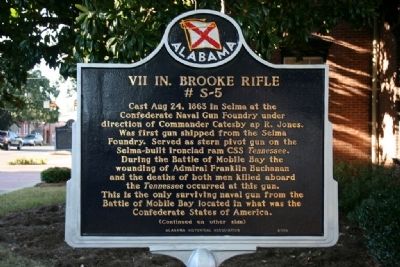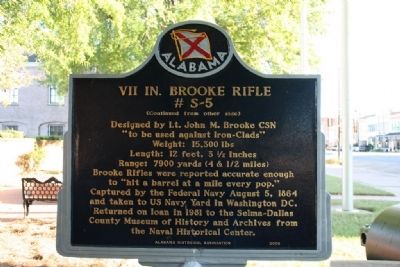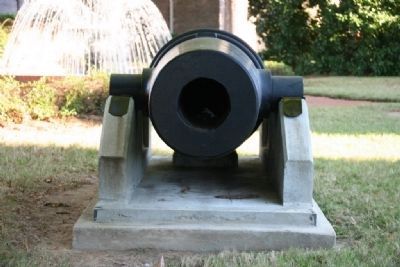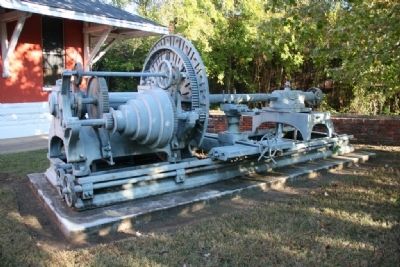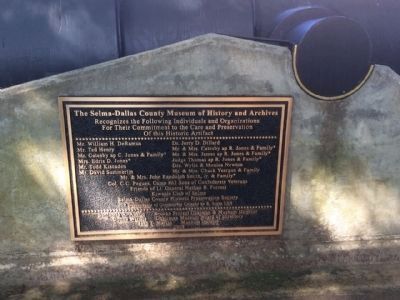Selma in Dallas County, Alabama — The American South (East South Central)
VII In. Brooke Rifle
# S-5
(Reverse):
Designed by Lt. John M. Brooke CSN
“to be used against Iron-Clads”
Weight: 15,300 lbs
Length: 12 feet, 3 ½ inches
Range: 7900 yards (4 & ½ miles)
Brooke Rifles were reported accurate enough to “hit a barrel at a mile every pop.” Captured by the Federal Navy August 5, 1864 and taken to US Navy Yard in Washington DC. Returned on loan in 1981 to the Selma-Dallas County Museum of History and Archives from the Naval Historical Center.
Erected 2008 by Alabama Historical Association.
Topics and series. This historical marker is listed in this topic list: War, US Civil. In addition, it is included in the Alabama Historical Association series list. A significant historical month for this entry is August 1899.
Location. 32° 24.578′ N, 87° 1.247′ W. Marker is in Selma, Alabama, in Dallas County. Marker is at the intersection of Broad Street (U.S. 80) and Selma Avenue, on the right when traveling north on Broad Street. Touch for map. Marker is at or near this postal address: 222 Broad Street, Selma AL 36702, United States of America. Touch for directions.
Other nearby markers. At least 8 other markers are within walking distance of this marker. Highlights of Selma History / William Rufus DeVane King 1786-1853 (within shouting distance of this marker); St. Paul’s Episcopal Church Est. 1838 (about 400 feet away, measured in a direct line); Votes for Women (about 500 feet away); Burning of Downtown (about 800 feet away); Sgt Robert Weakley Patton (approx. 0.2 miles away); Lieutenant John Tillman Melvin (approx. 0.2 miles away); The Sleeping Prophet (approx. 0.2 miles away); Federal Building and U.S. Court House (approx. 0.2 miles away). Touch for a list and map of all markers in Selma.
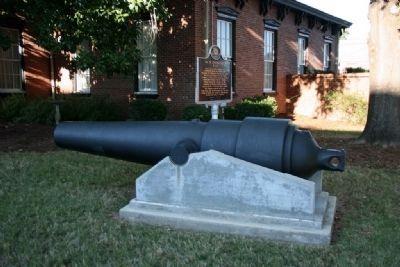
Photographed By Tim & Renda Carr, November 6, 2010
3. VII In. Brooke Rifle
This gun was cast at Selma Naval Ordnance Works on August 24, 1863. It received the registry number S5. As indicated on the marker, the gun was captured by Federals in the Battle of Mobile Bay. In the Navy Yard, it held trophy number 15.
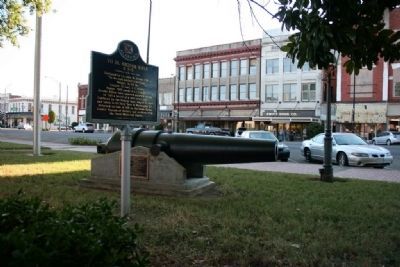
Photographed By Tim & Renda Carr, November 6, 2010
4. VII In. Brooke Rifle Marker
The double bands of the Brooke were constructed by laying six inch wide strips of hot iron around the gun tube. The strips were then butt-welded to form the bands. Although many consider this a "copy" of the Federal Parrott design, which used a wrought iron coil, Brooke used a completely different construction technique. Because Brooke used welded strips with inherent week points, double banding (and in some case triple banding) became a feature of the type.
Credits. This page was last revised on June 16, 2016. It was originally submitted on November 7, 2010, by Timothy Carr of Birmingham, Alabama. This page has been viewed 1,804 times since then and 57 times this year. Photos: 1, 2, 3, 4, 5, 6. submitted on November 7, 2010, by Timothy Carr of Birmingham, Alabama. 7. submitted on April 28, 2015, by Mark Hilton of Montgomery, Alabama. • Craig Swain was the editor who published this page.
